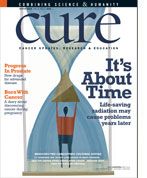Publication
Article
CURE
Cancer Chameleon
Author(s):
While sometimes one of the most aggressive of childhood cancers, neuroblastoma frequently goes away on its own.
William G. Woods, MD, director of the AFLAC Children’s Cancer Center in Atlanta, estimates that between 50 and 60 percent of cases diagnosed in infancy will spontaneously regress without any therapy. Its unpredictable behavior, however, makes this unusual type of cancer vexing and stressful for families whose infants, like Austin Matthews in "Born with Cancer, Blessed with Life," are diagnosed with the illness.
“Until it starts regressing, it can grow rapidly,” explains Woods. “And we’re not able to distinguish by genetic testing those tumors that are bound to regress.”
A solid tumor of the sympathetic nervous system, neuroblastoma affects about 650 to 700 children in the U.S. each year. When neuroblastoma has spread to other organs, Woods says, “there are some destined to do very poorly.
”The survival rate for stage 4 illness is less than 50 percent, Woods says.
Thus, parents often live in anguish as they await news from each new scan, which typically occur every three to four months. Each fever, cough and tummy ache can be a wrenching emotional experience.
Infants like Austin who are diagnosed with neuroblastoma must be watched very carefully, Woods says. That includes periodic CT or MRI scans.
Although the cause of neuroblastoma is unknown, most physicians believe it is an accidental cell growth that occurs during normal development of the sympathetic nervous system. The most common site for neuroblastoma to originate is on the adrenal glands, located above each kidney.





